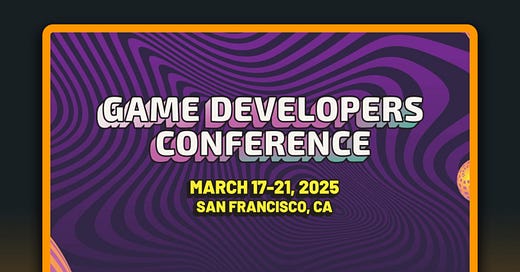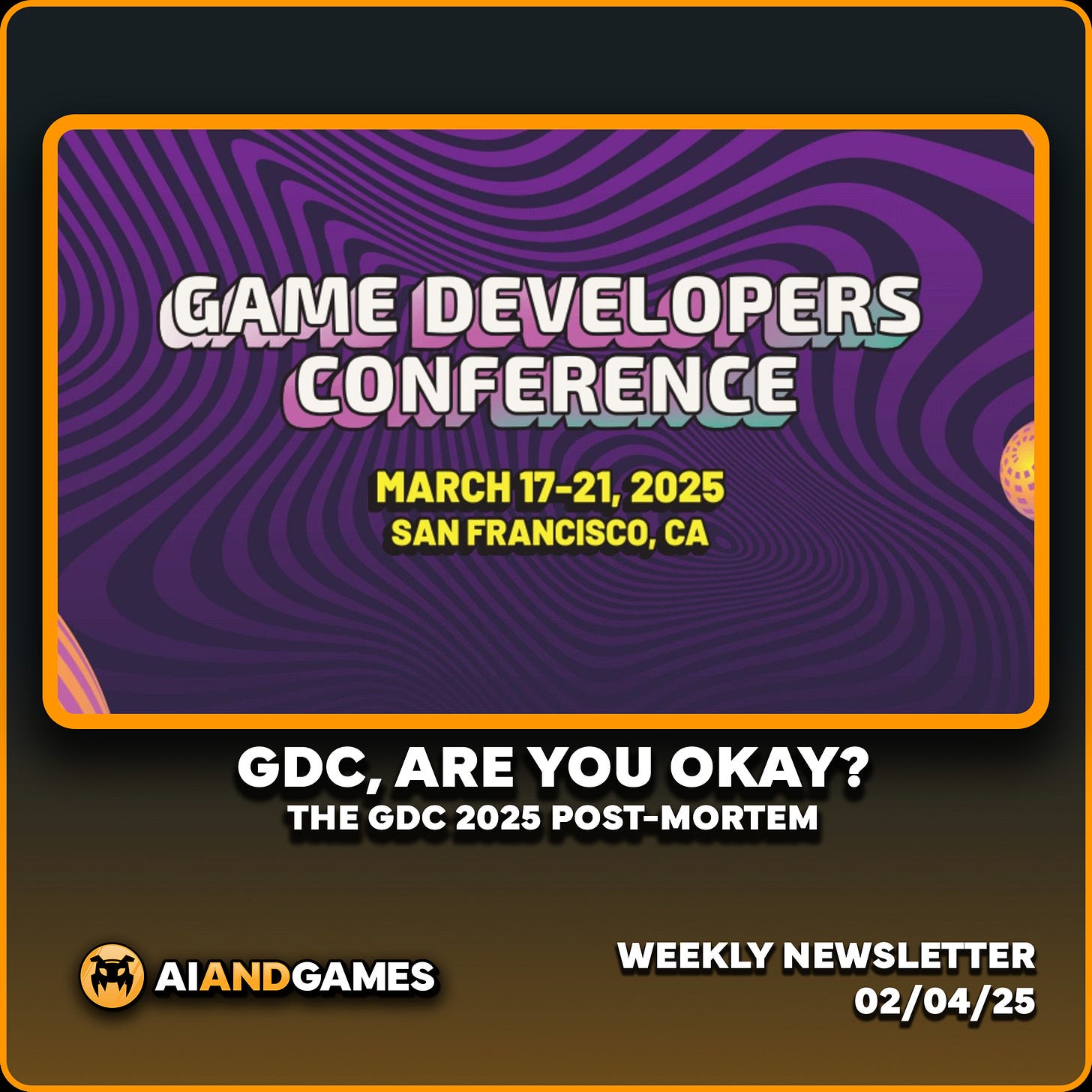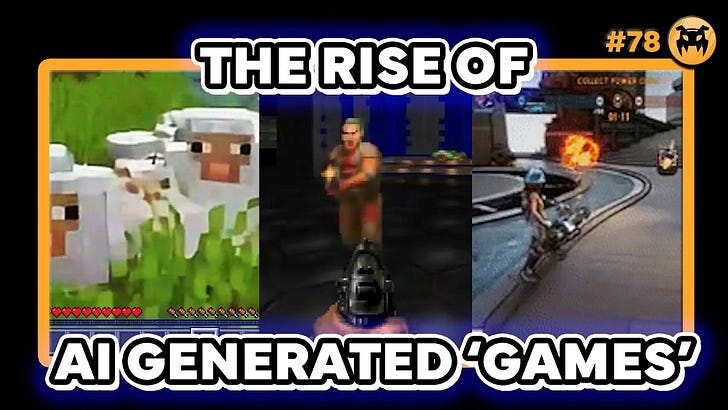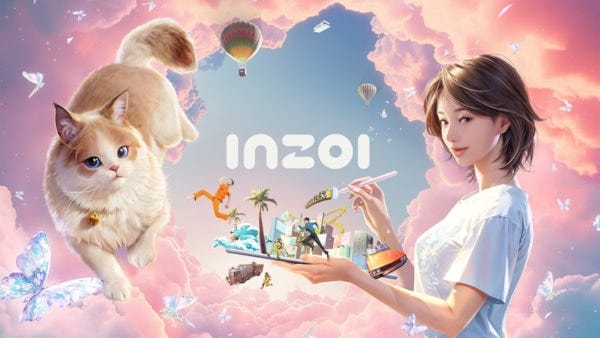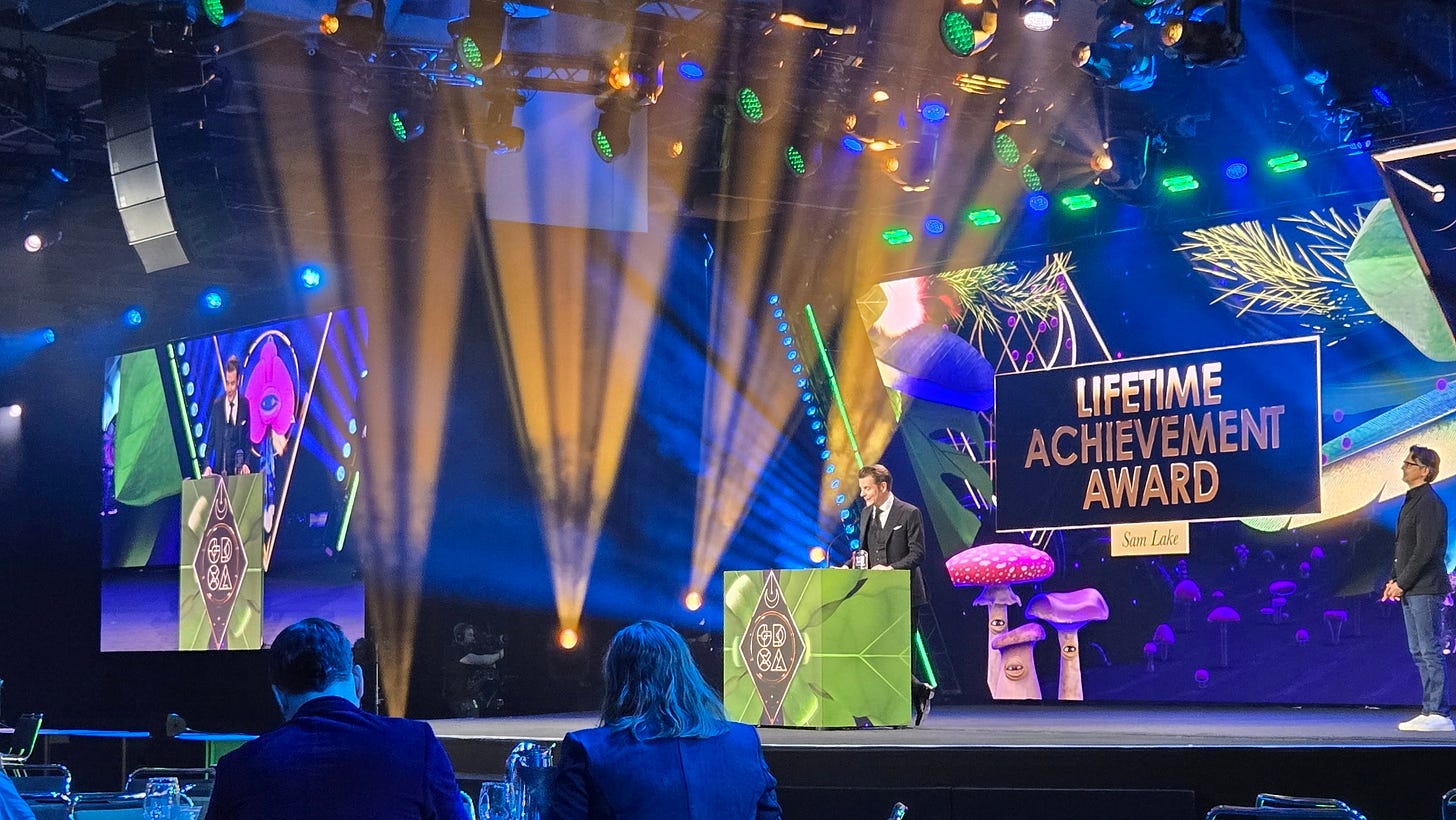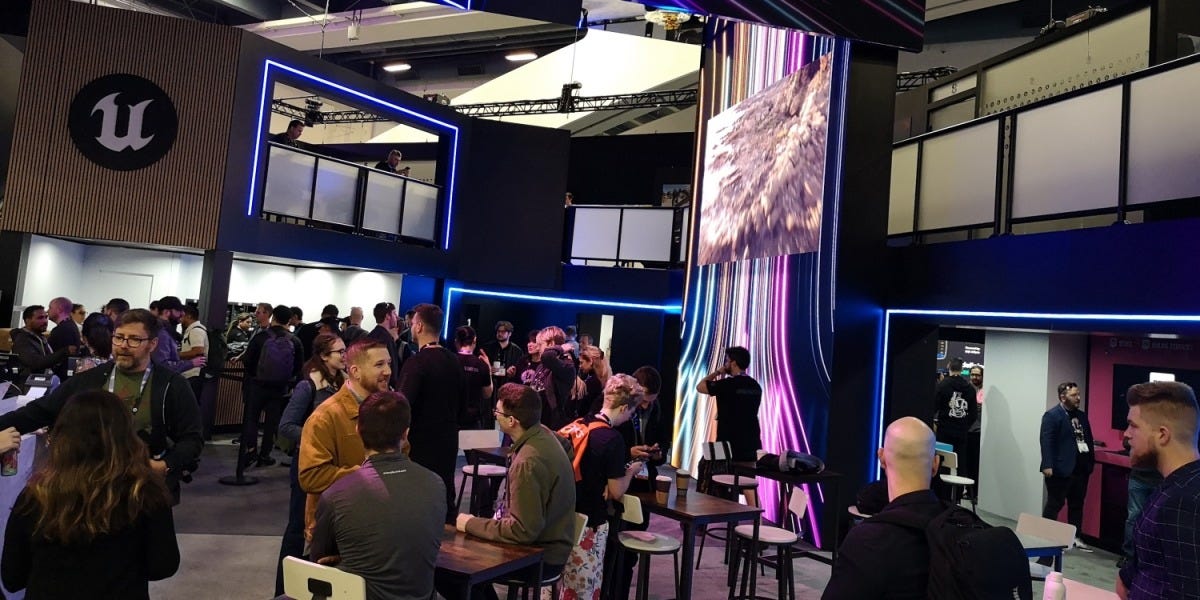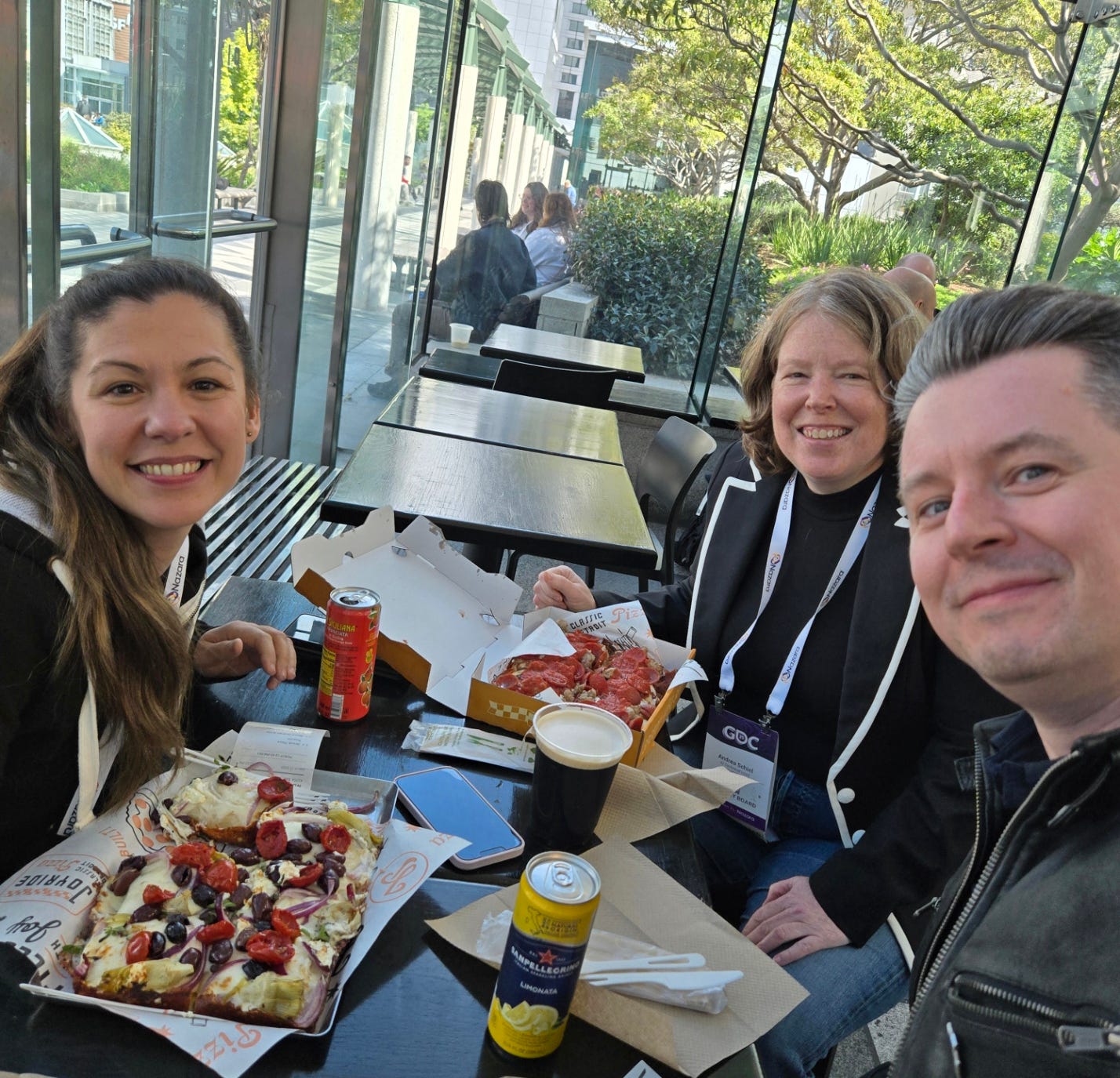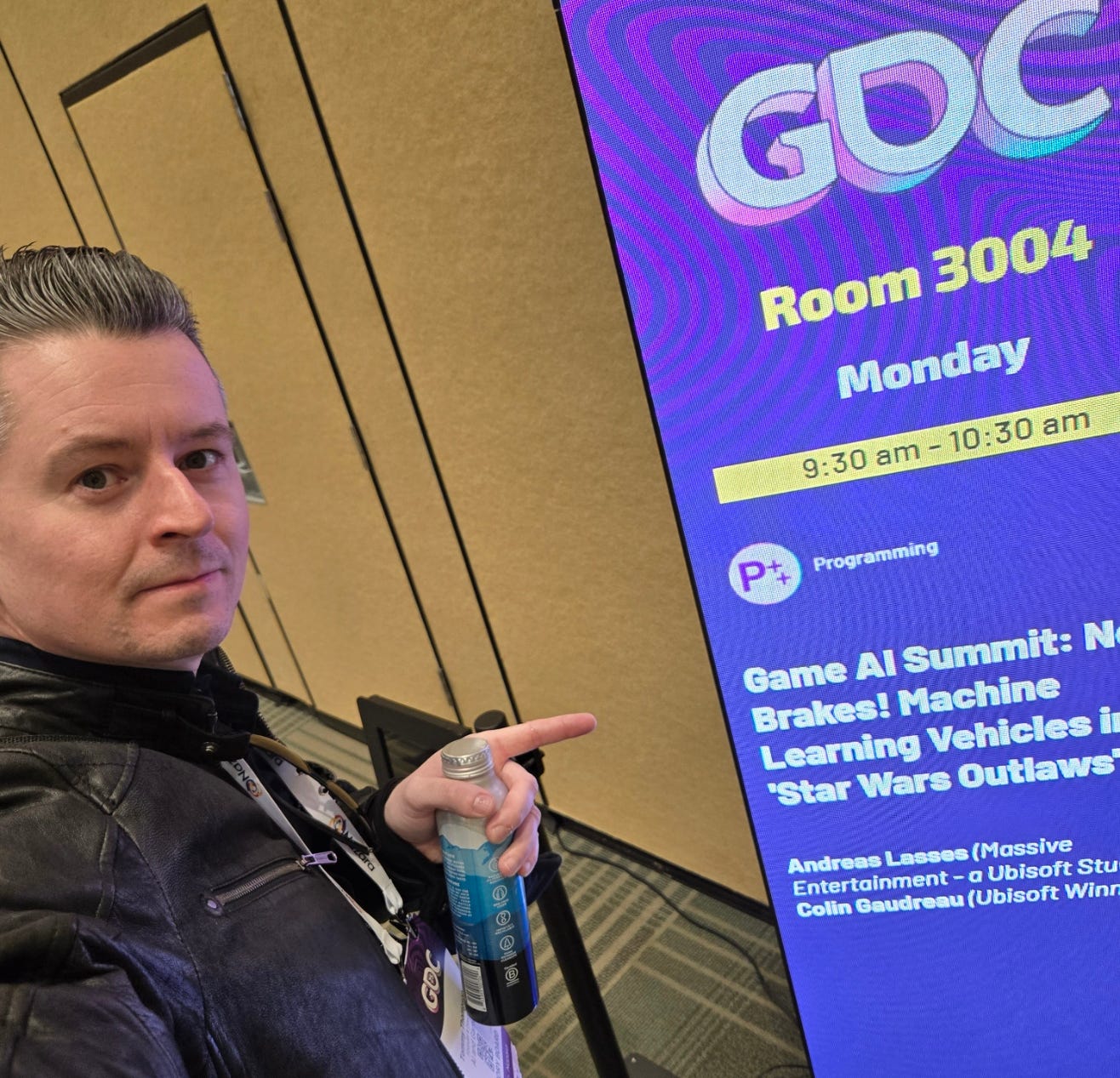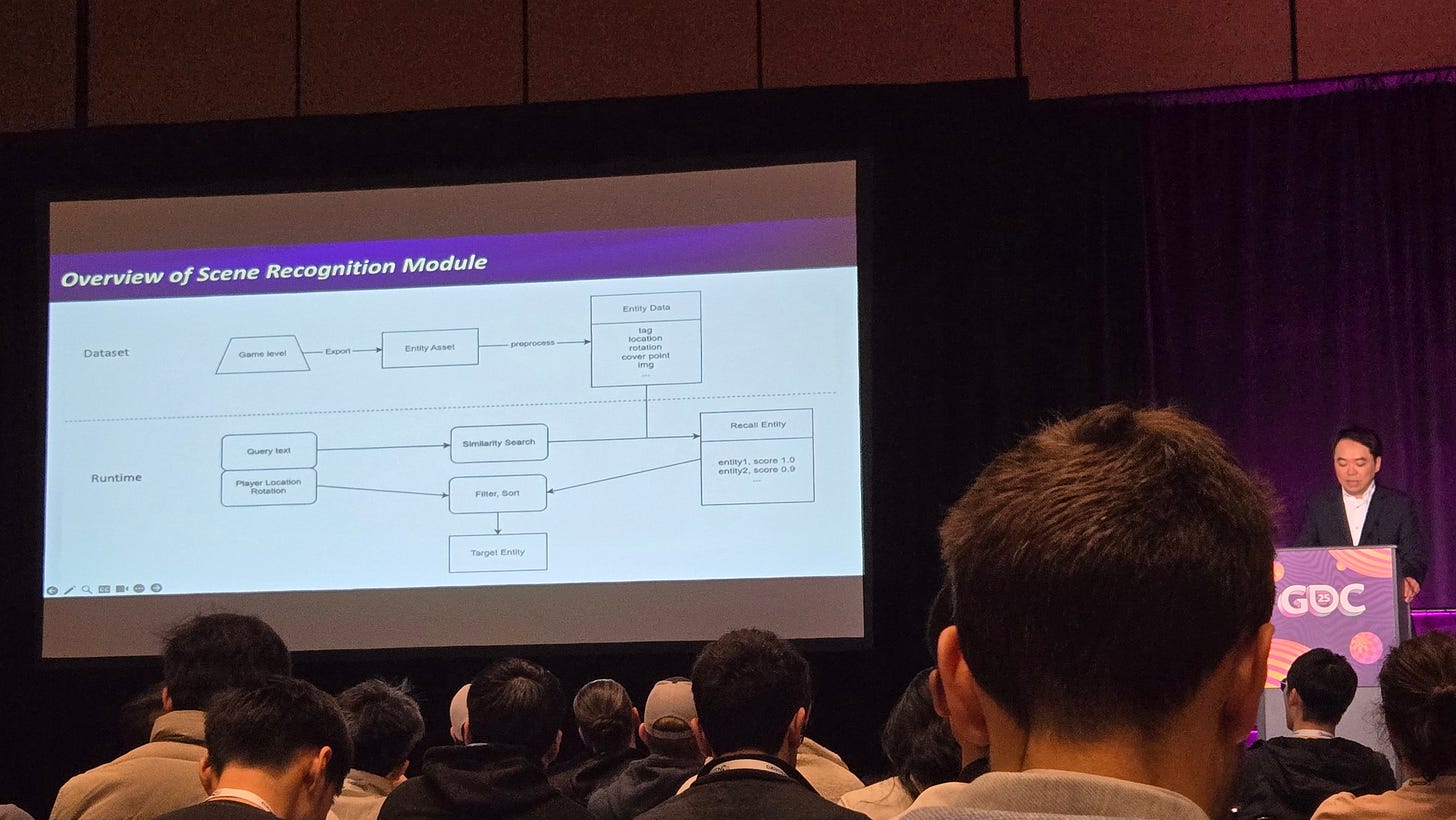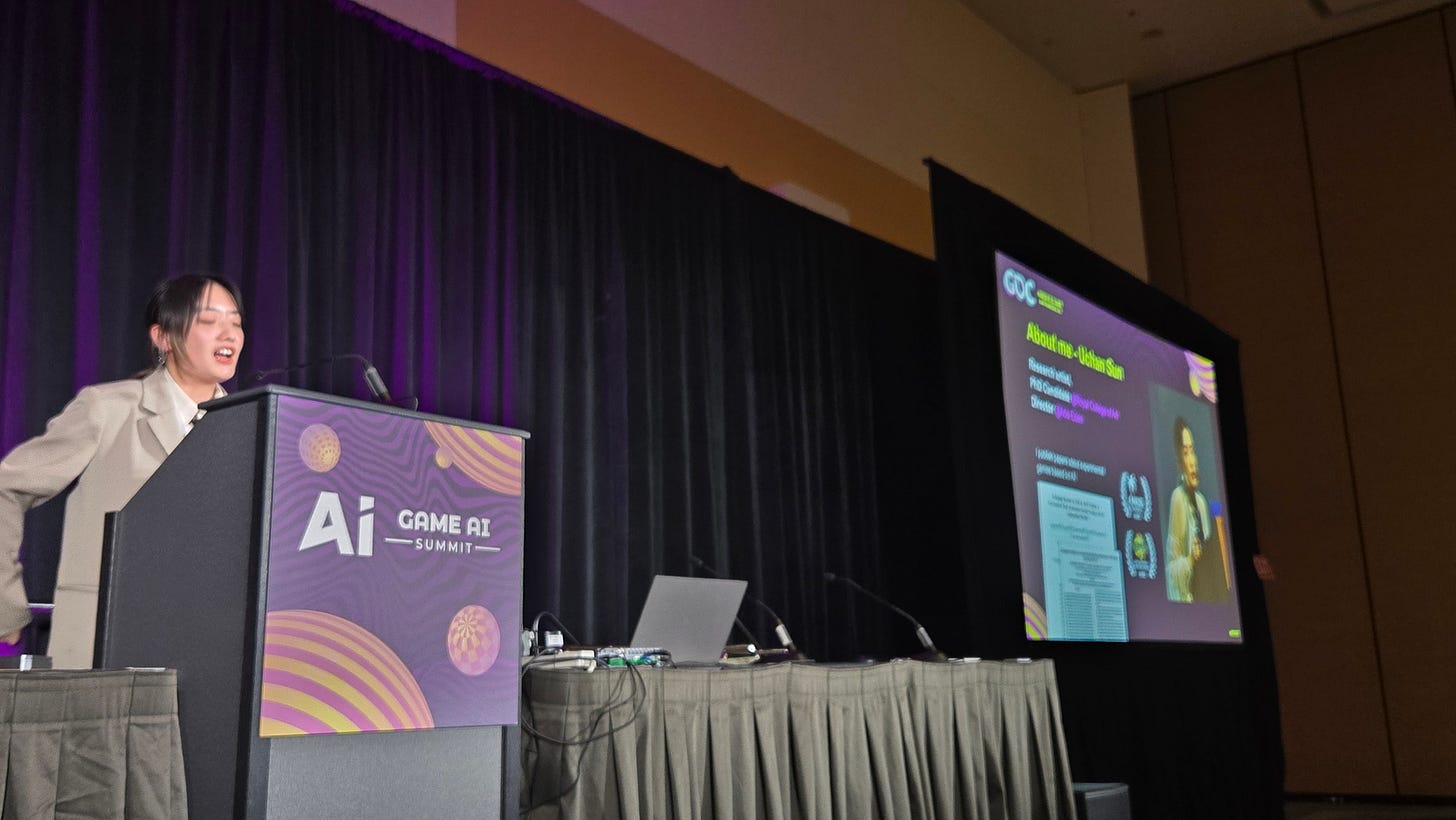Reflections on GDC 2025 | AI and Games Newsletter 02/04/25
A great event, but I think there are big challenges ahead in the coming years.
The AI and Games Newsletter brings concise and informative discussion on artificial intelligence for video games each and every week. Plus summarising all of our content released across various channels, like our YouTube videos and in-person events like the AI and Games Conference.
You can subscribe to and support AI and Games on Substack, with weekly editions appearing in your inbox. The newsletter is also shared with our audience on LinkedIn. If you’d like to sponsor this newsletter, and get your name in front of our audience of over 6000 readers, please visit our sponsorship enquiries page.
Greetings one and all, and welcome to the first edition of the
newsletter for April. I’m and having spent the last week or so sleeping and regaining my voice, it’s time to recount my experiences and summarise my thoughts on this years Game Developers Conference: an experience that continues to be the biggest show in town, but is beginning to fray at the edges.Follow AI and Games on: BlueSky | YouTube | LinkedIn | TikTok
Announcements
Well, after having little to say for ourselves last week, there’s a lot to announce today!
AI and Games x Nordic Game Jam 2025
At the time of publication I’m putting the finishing touches to my first speaking engagement of the year. I’m flying out to Copenhagen tomorrow to deliver a talk on Friday April 4th at the 2025 Nordic Game Jam. It’s a summary of quick tricks and smart design that can help elevate the behaviour of your non-player characters in a game, regardless of whether you’re using behaviour trees, machine learning or the latest generative AI tool.
New YouTube Video: The Rise of the AI Simulated ‘Game’
We’re back with a bang over on YouTube, with this episode coming mere days after returning from the US - the power of recently hiring an editor, amirite? In this episode we pick up on the recent topic of Microsoft Muse to highlight a number of these generative AI models that simulate games. I look at three projects in particular: Oasis (Minecraft), GameNGen (DOOM), and Muse (Bleeding Edge) and discuss each of them in detail, and show you them in action as well.
And of course, you can always ‘read’ the video via the link above.
Penultimate Drop of AI and Games Conference 2024 Talks
We released two more videos from the 2024 AI and Games Conference to the new YouTube channel last week!
Empowering Game Designers with Automatic Playtesting
We welcome Dr Raluca Gaina and Dr Diego Perez, two researchers from Queen Mary University of London who have since founded their own startup, Tabletop R&D. This talk digs into their work on supporting the tabletop game market by building automatic playtesting tools using AI. All with the goal of helping speed up development times, reduce costs and increase efficiency of an otherwise traditionally lengthy analogue process.
Analytic Geometry Is Your Friend
Eric Jacopin joined us at the 2024 conference to discuss the value of analytic geometry in the context of game development. Computing locations in a game is one of the most frequent features to be carried out: where to move to avoid or create a collision? Where to hide, move away or start a jump to escape danger? Where to fire, set off an explosion or set up an ambush? By approaching these issues as analytical geometry equations, you can generate good solutions very efficiently compared to traditional methods.
Goal State’s March Update is Live
Despite GDC really sticking its craw in a lot of my day-to-day work, we’re back to work on our Game AI 101 course. Be sure to check out the update that dropped on Monday on how things are progressing, and how soon our backers will begin to see content for review!
AI (and Games) in the News
A couple of quick headlines from the past week.
Generative AI Infused ‘InZoi’ Early-Access Launch has 85K Players on Steam
I discussed it in recent weeks, but the ‘Sims-like’ InZoi was the most wishlisted game on Steam last week, overtaking Hollow Knight: Silksong, and per SteamDB it is now out in early-access with over 85,000 concurrent players on launch day (March 28th).
I’ve been getting a lot of people asking me about this, including press requests, but I haven’t had time to play it (my weekend was spent with non-digital self-care activites, and trying to beat that big Lu Bu fight in Dynasty Warriors: Origins). But I hope we can swing around to this in the coming weeks.
OpenAI’s New Image Generator Highlights Lax Copyright Laws
Last week OpenAI announced an update to their image generation models and integrated it into GPT-4o. There are several significant changes and improvements in the model, notably a significant improvement in its ability to write words, and the creation of infographics that successfully meld text based information and image quality. It’s still prone to the regular issues of an image model, ranging from hallucinations to handling precise prompting, but you’d be forgiven for thinking the big innovation was that it makes Studio Ghibli-esque memes given how quickly they flooded social media.


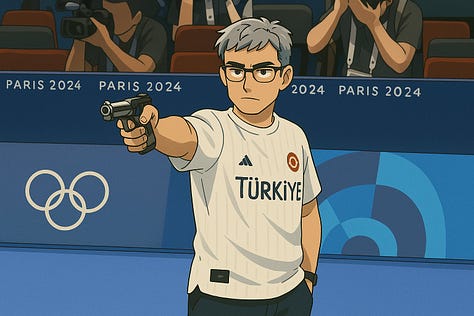
Even OpenAI are aware of this, and at the time of writing Sam Altman deciding to make his Twitter profile a Ghibli-fied version of himself - could that guy be any less cool? It all strikes me as a cringe-inducing flex against Hayao Miyazaki - it’s well documented that the “Spirited Away” and “My Neighbor Totoro” director thinks AI-generated works like these are “an insult to life itself” - but that isn’t the reason I bring it up.
Rather this is an opportunity to point out that this rather egregious effort to exploit the art style of a well known creative is permissible because Japan is one of the few nations in the world where it is legal to train AI systems on intellectual property (with some specific regulations). As such, while you may not like it - and after I saw two or three of them I was rather done with it - it is all very much above board and legal.
SAG-AFTRA Strike Adds Waivers for Student Projects and Game Jams
A small but nonetheless meaningful change over at SAG-AFTRA are two waivers created to support performers in participating in projects during the ongoing strike. The first, the Student Interactive Waiver Agreement, allows for student projects as part of course assessment in the United States to utilise talent who are part of the union. Meanwhile the second, the Game Jam Waiver Agreement, permits the participation of union workers provided it is not for profit and commercial release. A great way for union members to engage with the broader community, and utilitse their talents, while continuing to strike action against games companies that has now been ongoing for over a year.
GDC 2025: The Post-Mortem
So yeah, I returned from San Francisco on the 23rd of March, and then spent much of the past week not just sleeping and recovering my voice but equally thinking about what I saw at the event and what my big takeaways are.
Let’s get into it.
Disclosure: It’s worth raising as always when discussing GDC that I am a member of the advisory board for the Game AI Summit. This is a volunteer role in which I work with my fellow board members to curate talks, mentor speakers, and ensure the Game AI Summit continues to be one of the best events of the week. In return, I receive an all-access pass to the event.
GDC, Babe, Are You Okay?
I want to start by addressing what I felt was the elephant in the room, GDC felt like it was fraying a little at the edges.
I’ve often felt in the past three years attending GDC that there is an uncomfortable disconnect between the fantasy presented - this massive event for the industry, one that breeds significant FOMO in the community as it has a lot of money spent on a lavish presentation in the middle of the Moscone Center - and the reality that it’s in an area surrounded by closing businesses and sadly a lot of homeless folks who are pushed along and out of the way. Much of this was due to both the decimation of downtown San Francisco courtesy of COVID, alongside the long established failings of the United States in income inequality and support for the impoverished and destitute. But despite it all, GDC has largely been able to hold its head high as the games business event everyone must attend. I think this is the year where that is now being seriously questioned.
There are a number of broader issues at play here: the games industry has seen significant layoffs combined with studios failing to turn expensive projects into lucrative successes. This, combined with the US economy being in rather dire straits, has lead to a significant increase in costs. Nevermind ticket prices or booth space, going for breakfast for a coffee and scrambled eggs was setting me back $30 (£23). I began to long for London beer prices. Given the current trajectory both of the US economy and their administration’s fiscal policies, this doesn’t look like it’s going to improve any time soon. While GDC itself stated they had roughly 30,000 registered attendees in 2025 - the same as last year - I sincerely doubt that many people actually turned up. A point I’ll return to shortly.
In the three years I’ve been attending this was the quietest expo floor I’ve seen, both in terms of footfall as well as the companies in attendance. The lack of many of the big platforms and engines, most notably Epic Games (whose booth alone often accounts for about 5-10% of the entire show floor) plus Unity, PlayStation, Meta and Xbox (yeah they have that booth at the entrance, but like… c’mon) speaks volumes. Epic has decided their ‘State of Unreal’ - a staple of GDC - has now been moved to Unreal Fest in Orlando in June.
The other thing that struck me, was how many companies were running mini events either in the west hall, across San Francisco, or not so far away. Both Arm and Unity ran developer summits in the west hall, transforming a room into both a booth and a talk space, Nvidia of course runs the GTC event in San Jose to around 25,000 attendees, Pocket Gamer ran an event nearby, and while they had a booth in the west hall Xsolla ran their entire GDC in The Howard hotel.
It feels like we’re seeing the same trends that impacted E3 hit GDC, in that businesses are beginning to question the value of the event. Both in the context of cost of the venue, but also what it brings for B2B engagements, particularly with increasing space and opportunity at other events in markets that are also seeing growth in userbase and player spend in Europe (Gamescom, Reboot Develop), South America (Gamescom Latam), China (ChinaJoy) and Japan (Tokyo Game Show).
This is a point I heard in meetings with several big companies, in that they’re very cautious about how much money they spend on sending people to GDC given they’re suspecting the ROI isn’t there at the moment. Plus of course the aforementioned economic changes in the US means sending 3 people in 2025 costs the equivalent of sending 5 or more in 2023.
This is a point friend and co-conspirator of
, the ever lovely had to say in his own a couple weeks back. Nice to know it’s not just me.Community Safety is Paramount
So this ties heavily into the aforementioned attendance numbers. Right now people do not feel safe attending events in the United States - a point only reaffirmed by several countries changing their travel guidance for visiting the country. This is regardless of GDC being in California - a progressive ‘blue state’. This is particularly of importance to women, and many within the LGBTQIA+ community, in addition to those from around the world who will struggle to enter the US given their country of origin.
One of the most positive and rewarding sentiments I heard from many people at our Game AI Summit was the sense of community in our hall. Naturally we are but one microcosm within a giant event, within a giant country, but it’s important we treat our attendees and speakers with dignity, respect, and kindness. While myself and my fellow advisors must maintain our editorial integrity for the work we do, it’s vital we act as ambassadors to support and welcome people of every walk in life who will engage with our community with the same passion and respect as we do. That’s how communities survive, and grow.
I know of several people who backed out of attending, even speaking, at GDC this year because they were worried for their safety. While GDC has had issues with attendee safety before, notably at parties and satellite events, this is very much a broader political issue and not necessarily the event’s fault. But I believe GDC will need to act to provide more opportunities for remote speakers in 2026 as more and more of the industry refrains from visiting the United States.
Game AI is Facing An Existential Crisis
I’ve spoken about this in person at numerous venues, but I don’t think I’ve ever put it down in writing. I genuinely believe that Game AI - the practice of adopting AI technologies of various shapes and sizes for gameplay purposes - is facing something of an existential crisis.
I could write an entire newsletter on this - maybe I will too - but the gist of it is that right now with a collection of layoffs leading to people leaving the industry, AI hype controlling the narrative, academic departments losing funding or shutting down, and events becoming difficult or unsafe to attend for our community, we are seeing a talent drain. It’s slow, it’s gradual, but it is happening.
I worry about the future of the AI community in the US, given the Game AI and ML Summits at GDC are the only real event of this nature in North America. I won’t lie that founding the AI and Games Conference last year was our collective effort to provide support to the European community. But I do worry about what’s happening across the pond as well.
The AI and ML Summits Remain Strong
This year we had a great round-up of talks across both the Game AI and ML Summits at GDC. Sadly I didn’t attend anything from the ML Summit - given we make sure to attend all the talks at our summit and support our speakers - but I already have them bookmarked.
I made a thread about this on both BlueSky and LinkedIn, that the Game AI Summit had a great line-up this year. With meaningful adoption of machine learning for the speeder bikes in Star Wars: Outlaws, classic game AI challenges in enemy NPCs for Alien: Rogue Incursion, summaries of academic research in visualising diversity in content generation systems, and some practical advice on how to use generative AI as part of gameplay with the upcoming 1001 Nights. When the talks hit the vault, I’ll do a summary of my favourite talks as an article on the site.
We had some great feedback from attendees on the quality of the talks throughout the week, and that speaks to the importance of having an advisory board that maintains their editorial integrity, and doesn’t embrace the hype from across the sector on AI all that readily. Perhaps more importantly it speaks to how great our speakers are too! But for us, our job is to ensure every talk has a meaningful takeaway that an attendee can take back to their company and act upon it. Or simply allow them to see the ongoing trends in the sector that reflect actual industry practice. We’re starting to see some interesting and relevant generative AI applications at both GDC and our own conference. But this requires us to do the due diligence and maintain the rigor our attendees have come to expect.
The AI Revolution is Here, But is Anybody Listening?
I still recall back in 2023 when GPT-4 was launched, it dominated every conversation I was having at GDC. Everybody was talking about it, and I had multiple conversations with game developers who worried that this was a turning point, that how things operate within the industry was going to change fundamentally. Ultimately the big takeaway that year was the biggest development in AI (in and for) games had happened outside of the Moscone.
Yes, there is some truth in that assessment, as we saw in the newsletter but a few weeks back, we’re seeing generative AI be used in a variety of business capacities. But now that the AI revolution is here… nobody is really talking about it. There were a lot of sponsored sessions on AI throughout the week from the likes of Nvidia, Google, and Tencent, but it was interesting how either nobody in my network was interested in them, or that they came away from them rather bemused by it all.
I think this speaks largely to my point made in the newsletter at the end of 2024, that we need to ship stuff. I think people are increasingly less panicked about another long-drawn talk about a tech stack that has not faced the reality of being in a shipped game. There was a great turn out for the generative AI talk at the AI Summit from Yuqian Sun and the team from Ada Eden on 1001 Nights, and while I sadly didn’t make it in person I heard good things about the talk by Meaning Machine on Dead Meat at the Nvidia stage. But it was interesting how little impact AI talks were having on the general discourse of the week.
I think perhaps the 1001 Nights talk was indicative of something fresh: a game that is actually close to shipping that uses the tech - critically they ended the talk with a slide advertising they’re seeking investors to help them ship! It was, from my perspective at least as a summit advisor, one of the reasons we picked the talk over the dozens of half-baked, unfinished, grandstanding generative AI pitches we received.
The past two years there has been some sort of AI ‘drama’ as it were as something was announced that caught everyone’s imaginations - typically in a negative way. This year? Nothing. The only AI drama I heard about was that ridiculous AI-generated trailer for the Ark DLC I talked about last week.
That said, generative AI was the focus of most meetings I had in and around GDC. So while the discourse is not that pervasive on the show floor or in the gardens (at least not in a positive way anyway), the conversations are very much happening in bizdev spaces. On one hand companies are worried they’re falling behind, while equally many others are future proofing courtesy of acquiring AI talent, developing a stronger understanding across their business how or if AI can support them, trying to get to grips with the implications of AI regulation in Europe on product launches, and experimenting on their own works internally. This latter point being perhaps the most critical: I hear less and less collaborations with external companies, and a greater emphasis on doing it themselves now that the technology is becoming more pervasive and better understood.
Presentation is Key
Returning to the sponsored sessions, I have to say having attended several of them I was rather aghast at how poorly (some of) these presentations are put together.
Talks that were poorly thought out, lacking in technical details, and often suffering from technical issues, and a lack of preparation (almost like they didn’t have an advisory board to apply some editorial rigor… huh?). There was one talk in particular on the Friday that not only failed to discuss what was, in my opinion, the most interesting aspect of the technology they had built, but the presentation was split across multiple laptops that had not been properly tested and set up - only for the AV team to have to rescue them, twice.
A little reminder for everyone out there that, contrary to popular belief, presentation is everything! You should not be letting this sort of thing happen at GDC of all places. It shows both your speaker and the company in a bad light if a bunch of game developers and technologists, supposedly working at the frontier of this field, can’t figure out how to run a PowerPoint deck.
Of course minor things will happen, that’s fine - and critically audiences are rather forgiving. But it’s your job to minimise these things as much as possible. Do the tech test, check the videos, get those audio levels addressed and all minimise the ways it which it can go wrong. Prepare for the worst, and hope for the best right?
Some of this is down to how GDC operates, in that there is limited time to get in and test your talks in advance. But also the speakers need to be making an effort. On that note I want to give a shout-out to Andreas Lasses and Colin Gaudreau from Ubisoft who came down to the AI Summit first thing in the morning (around 8:30am) to test their talk an hour in advance. We had a bunch of technical hiccups that morning, to the point that their presentation on machine learning in Star Wars Outlaws ended up being delivered on my laptop, and it went really well!
Wrapping Up
Clearly GDC is stirring up a lot of thoughts I have at the moment - and there’s scope for even more on the topic - but we’ll save that for another day. For now, I have to return to writing Goal State, and finishing this presentation for the Nordic Game Jam!
Thanks once again for reading the newsletter, and I’ll catch you all next week!


